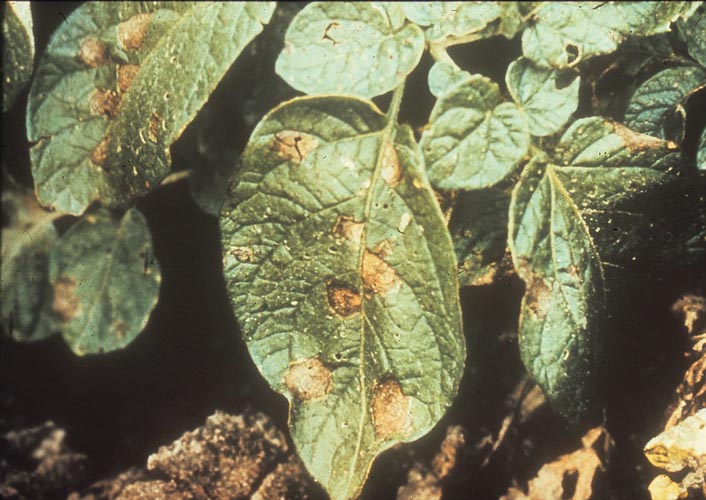What is an early blight of tomato, how to identify it, and how to prevent and control this common tomato disease? Read on the get answers and keep your tomato healthy.

What is Tomato Blight – Causes and Symptoms
The most common form of Tomato blight is the so-called early blight. The disease is caused by a fungus Alternaria solani and it attacks leaves, stem, and fruit, but the foliage infection is most common and the problem usually starts there.
The fungal spores overwinter in the soil, which means that disease can occur early in the season just as soon as the optimal weather conditions appear. The infection occurs during early to mid-season, and just as any fungal disease, it favors humid weather conditions and prolonged periods of rain. Along with high humidity, temperatures above 75 degrees F are the optimal conditions for the fungal disease development.
The first symptoms of early tomato blight appear on lower, older leaves of a plant. The disease is characterized by circular dark spots (brown to black), with concentric circles, ¼ in – ½ in diameter. As the disease mature, the circles become larger with distinctive yellow halos around the edges. The presence of these yellow edges is the best way to distinguish early tomato blight from late tomato blight, and Septoria leaf spot as well. While caused by the different fungus, fungicides for late blight in tomatoes are mainly the same as tomato early blight fungicides.
Once the tomato leaves are infected, they go yellow and drop off the plant. The plant that loses a large number of leaves this way, remains unprotected and exposed to sunscald which directly leads to the reduced yield.
Early blight of tomato can affect the stem and fruit, as well. Stem displays dark, sunken spots at or above the soil line, while the same, collar rust appears on the stem end of the fruit. The infected fruit often cracks right on the stem.

How to Control Early Blight – Prevention and Fungicides
The best control measure for early tomato blight is prevention. Keeping your plants nourished can protect them not only from early blight but also from other diseases. Consider these steps as prevention:
- Plant resistant varieties. Many tomato varieties are developed to be more resistant to various diseases and be less susceptible to early tomato blight. The varieties resistant to early blight are ‘Legend’, ‘Juliet’ ‘Early Cascade’, ‘Floramerica’, ‘Jetstar’, ‘Tommy Toe’ ‘Manlucie’, ‘Old Brooks’ ‘Supersonic’, ‘Big Rainbow’, ‘Surecrop’,’ Manyel’ and many others.
- Buy Certified Seed. Use seeds and seedlings from reputable sources. Be sure to inspect any plant before planting it in your garden.
- Rotate crops. Since the spores of the fungus that attack tomato can overwinter in the soil, it’s advised to avoid planting tomato or eggplant in the garden area where tomatoes were planted during the previous season.
- Leave space between tomato plants. An extra spacing provides proper air circulation which helps to keep plants less susceptible to fungal attacks. Stake tomato plants, keep them dry and keep the foliage off the ground.
- Mulch. A layer of mulch prevents fungal spores to spread from soil to the plant. Do not mulch until the soil is warm.
- Water from below. Avoid watering the leaves and be sure to water soil and the lower part of stem only. An irrigation system is especially beneficial since it only moistens the soil, while keeping the foliage dry.
- Inspect plants regularly. Detecting early blight symptoms during the early stage can prevent spreading between the plants. Sometimes destroying an entire infected plant can save other plants from getting infected.
However, if early tomato blight occurs despite the prevention measures, be sure to:
- Remove the infected leaves and avoid using them for composting. Destroy them and keep your garden tool clean.
- Try organic fungicide first. A copper-based solution works well on early tomato blight. Copper fungicide spray or bio fungicide called ‘Serenade’ are powerful tools against various soil and foliar bacterial and fungal diseases.
- Chemical early blight fungicide. Chlorothalonil is a broad spectrum of fungicides used to control fungi, mold, and bacteria on various plants, particularly vegetables such as tomato or eggplant. The fungicide fights early tomato blight effectively and it’s sold by various brand names (Daconil, Bravo, Fungonil). If you decide to go for a chemical approach, be sure to apply the product according to the directions on the label.